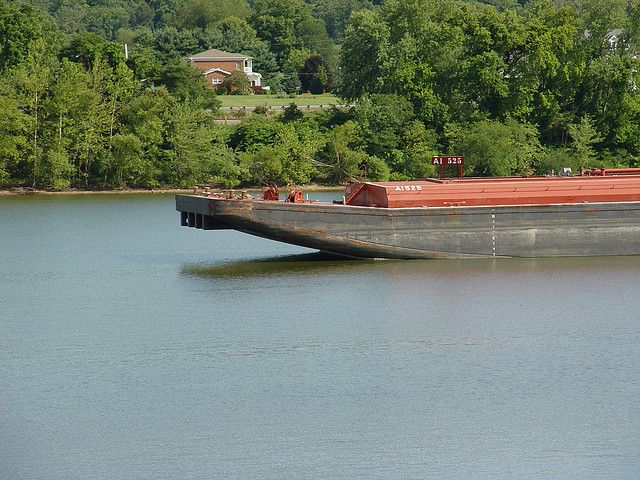As the fracking boom continues across the U.S., a new option for moving the enormous quantities of wastewater that result from the process is raising fears about threatened water quality.
The Coast Guard is currently deliberating a proposal that would allow the oil industry to move fracking wastewater, which contains undisclosed proprietary blends of chemicals, by barge down some of the nation’s rivers. Barge transport would be more energy efficient than trucking and would also spare wear and tear on roads. A 30-day period of public comment closed last week, and the Coast Guard will take those comments under consideration before releasing its final decision on the proposal.
Ohio is one place where environmentalists and others are concerned that a wastewater spill could contaminate the drinking water source for major cities, such as Cincinnati.
According to the Cleveland Plain Dealer, the prospect of barges moving fracking wastewater from Pennsylvania and eastern Ohio down the Ohio River prompted many people to submit comments in opposition to the idea during the period for public input. As the Plain Dealer reports:
“What happens to the water when there is a spill, and what happens to the water intakes on the river?” asked James O’Reilly, a University of Cincinnati law and public health professor and a city council member in the suburb of Wyoming. “I am concerned, as an elected official, about what happens to the water intakes.”
The Ohio River Valley Water Sanitation Commission said in a letter to the Coast Guard that the wastewater “can pose an immediate threat to drinking water utilities if released to the river.”
Oil industry representatives insist that fracking wastewater is safer than many other materials moved on rivers that already see heavy industrial traffic.
Operation of a single fracking well can require more than 4 million gallons over a two-to-five-day period. Many of the wells in Pennsylvania, where the hugely productive Marcellus Shale formation has created a fracking boom, feature geology that makes it difficult to dispose of the resulting wastewater. Some is treated at plants and then released to local streams and rivers, but much is moved by truck to disposal locations, mostly in Ohio, where it is pumped deep underground into what are called injection wells. A series of earthquakes at the site of an injection well in Youngstown, Ohio raised the alarm about that process and caused the state to modify its regulations about the depth and frequency of such pumping.
As I wrote in a piece on Youngstown earlier this year, the same company whose well was associated with those quakes was accused of dumping fracking wastewater into drains leading to the city’s Mahoning River. An employee of the company pleaded guilty this summer to pouring tens of thousands of gallons of such water from storage tanks into storm drains on at least 24 occasions, sending an unknown mix of saltwater brine and various chemicals, including toxins like toluene and benzene, into the local ecosystem.
The question of what, exactly, is in fracking wastewater has long been a central point of controversy, as oil and gas companies have claimed protection from disclosure on the grounds that the blends of water used in the process are trade secrets. But environmentalists have said that the disposal of such water poses a threat to drinking water. One recent study found extremely high concentrations of radium, a naturally occurring radioactive element in many rocks, in areas downstream from a fracking wastewater plant, along with chemicals including chloride, sulfate and bromide.
The mystery surrounding the composition of fracking wastewater is complicating the Coast Guard’s proposal. Current regulations would require barge owners to have the water tested and analyzed before moving it. As each barge load could contain 10,000 gallons of wastewater from different sites, it would be difficult for operators to make sure of the source of any unapproved chemicals that might be detected.
The controversy over moving fracking water by barge is just one more indication of the shale oil industry’s complex potential impact on the nation’s water systems. Fracking, in case we’ve forgotten, is short for “hydraulic fracturing.” Water — lots of it — is an essential part of the process. We are only beginning to wrap our minds around all the different consequences that implies.
Watermark is made possible with the support of the Surdna Foundation.

Sarah Goodyear has written about cities for a variety of publications, including CityLab, Grist and Streetsblog. She lives in Brooklyn.

















